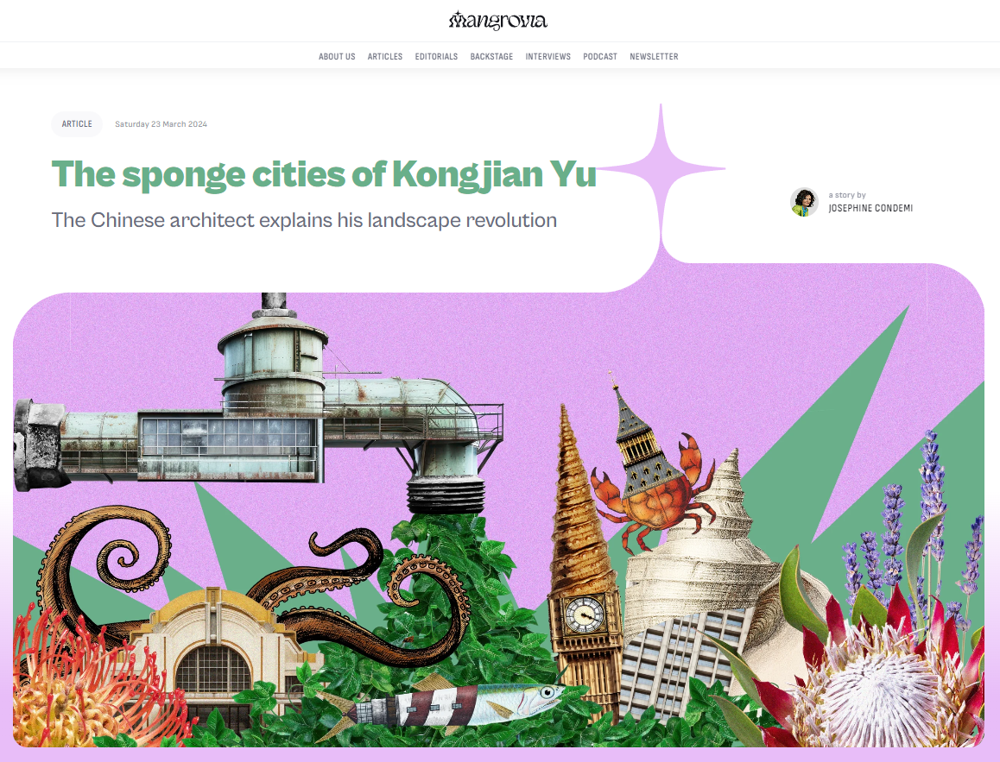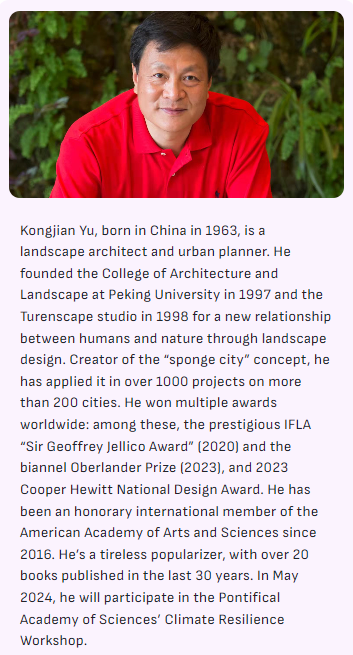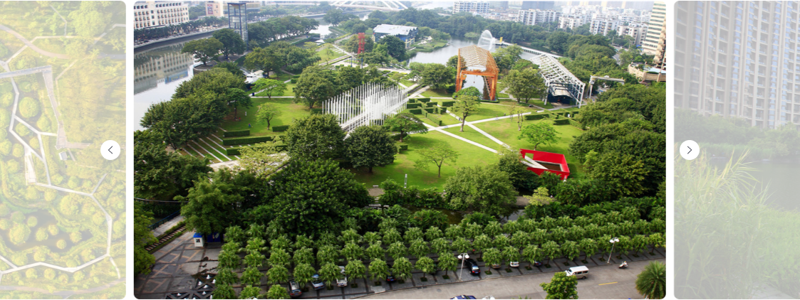Mangrovia:俞孔坚的海绵城市

Cities capable of absorbing water and releasing it when needed: Kongjian Yu has changed the approach to urban planning in the People’s Republic of China. Here’s how
In Mexico City, water was rationed in February 20241, as in Cape Town in 20182. Indonesia’s capital Jakarta is also sinking because of excessive groundwater withdrawal3. London, which relies on its two rivers for its water supply, is experimenting with ways to store rainwater4. The relationship between cities and water is increasingly complicated and the extreme events due to climate change are putting it under even more pressure. «So far we have failed: the temperature continues to rise and people continue to burn coal: we need a different approach» emphasises Kongjian Yu, the architect who came up with the concept of the sponge city5, i.e. the city that manages to retain water during floods and release it during periods of drought. Yu has applied the concept in a thousand projects over the past 26 years.
«Traditional plumbing systems will fail with climate change: we need to change the mindset of the people and the politicians who make the decisions» says the man who convinced the Chinese Communist Party to change its approach to urban planning: since 2004, his Ten Strategies for Urban Ecological Infrastructure Construction6 have become guidelines of the Ministry of Construction, and since 2013, the construction of sponge cities has become a strategic national issue.
«All modern cities are based on grey, industrial, inflexible technologies based on reliable climates» Yu says. «In contrast, the green technology of the sponge city is based on three principles: hold water in place as much as possible, slow down its flow, don’t fight against water. The world is small and, to solve the problem of climate change, we have to think of it as a sponge, a sponge planet».

In search of the lost landscape
Yu’s story began in a village of 500 people near Shanghai in southern China: «From ’63 to ’80, so for my first 17 years, I lived in this village surrounded by hills, at the junction of two main rivers: White Sand Creek and Wujiang» he says. «Every day, since I was 7-8 years old, I followed my father, a very experienced farmer, to work in the commune: I grew rice, sugar cane, wheat, anything. The area was very productive, but water was always a major problem».
The monsoon climate is a humid tropical climate, named after the winds that blow from the sea towards the mainland and cause periods of heavy rain alternating with severe droughts. «Each village had its own water warden, responsible for irrigating all the rice fields, with the task of monitoring the flow 24 hours a day,» Yu recalls. To survive, water management in the village relied on two parts: a system of low dams along the river, used to slow down the flow of water and divert it to the paddy fields, and many small water storage ponds, to be used in the dry season also for drinking and washing. «One day I fell into the river during a flood and survived only because the river was rich in vegetation and I was able to cling to a willow tree» Yu recalls. «The idea of the sponge came from there, from the life experience of those years, which is also about the impact of water on the whole ecosystem: I used to take a buffalo to graze grass along the river, I rode its back along the stream, near the pond. This is my story».
When he returned from university, Yu found the landscape changed: «It was the time of China’s opening-up policy. We became developed and so urbanisation, industrialisation, and the use of cement and pesticides arrived: we filled the pond, channelled the river, formed a dam to create a large reservoir and suddenly my romantic childhood landscape disappeared, replaced by a system of concrete pipes. No more fish in the stream, no ponds, no birds, no flocks, no buffaloes, no frogs. Only fields for rice, for crops, canalisation of the river that had become about five metres deep and slippery. Drownings in the river were a daily risk floods and droughts had become a problem. And neither reinforced concrete nor further funding for grey technology could solve them».
Game theory applied to landscape
From ’92 to ’95, Yu attended Harvard’s Graduate School of Design and came into contact with the debate triggered by the publication of The Diversity of Life7 by sociobiologist Edward Wilson: «There was this famous quote: “Destroying rainforest for economic gain is like burning a Renaissance painting to cook a meal”, which for me reflected the all-Western dilemma between protection and development,» Yu recalls. «I came from China, which was very poor at the time. I understood that a compromise had to be found between cooking and protecting nature: not losing biodiversity but maintaining productivity, as was the case in my childhood».
For his thesis, Yu then identified the security patterns8, the parts of the landscape that are critical to the ecological process: based on the water flow, he drew with GIS the security perimeters to be safeguarded, the red lines of the landscape to be protected. «It’s like Nash’s equilibrium theory9, it’s about negotiating to find a compromise between different needs» Yu reiterates. «When I returned to China in 1997, I tried to apply my theory, because the whole country was suffering from this kind of mistreatment of the landscape».
In 1997, Yu founded the Center for Landscape Architecture and Planning, which later became the College of Architecture and Landscape at Peking University in which he taught ecologically based landscape planning and design, and a year later, in 1998, it was the turn of Turenscape, a crasis of the words tu, meaning earth, ren, meaning man, and scape, meaning landscape, for a new alliance between humans and nature. «As soon as I came back, I started giving lectures, talking to local authorities about respecting ecology and local cultural heritage: I gave more than 600 lectures to convince decision-makers of various ranks to transform the landscape in an ecological sense,» Yu recalls. «They agreed with me but asked me for concrete examples».
The opportunity came in 2000 with the Zhongshan Shipyard Park project: «It was an old shipyard, it became one of China’s first contemporary parks,» Yu emphasises. «We protected both the trees and the industrial heritage, but we removed all the concrete pavement and rediscovered the natural embankment by reintroducing native vegetation».
A few years later, the Turenscape studio created the Yongning River Park in the flood-prone province of Zhejiang with the iconic The Floating Gardens that transformed the newly cemented river into a spongy, flood-absorbing river. «At that time, river channelling was at its peak» Yu recalls, «So this naturalisation project was against the trend, drove up property prices and became an attraction for visitors from all over the country».

In order two photos of Zhongshan Shipyard Park, two photos of Taizhou Yongning River Park, two photos of the Benjakitti Forest Park. Source: Kongjian Yu, Turenscape. All rights reserved. Reproduced with the author’s consent
Today, the Turenscape studio consists of more than 500 people and has designed and built more than 1,000 projects in over 250 different cities. «My idea of landscape architecture is that we have to go back to the basic issue, survival, and find a holistic solution, which is both functional and aesthetic. It is an updated version of primitive nature-based agriculture, an integration of modern science with the art of beauty» stresses Yu, who keeps an eloquent inscription on his bookshelf: Everything needs to change.
1. A Città del Messico l’acqua è un problema politico. (2024). In Il Post. ↩︎
2. Level 6B Water Restrictions. Western Cape Government. ↩︎
3. Renaldi, A., & Program, J. I. V. M. (2022b, July 29). Indonesia’s giant capital city is sinking. Can the government’s plan save it? In Environment. ↩︎
4. Water Resources. London City Hall. ↩︎
5. Kong-Jia, Y. (2015). “SPONGE CITY”: THEORY AND PRACTICE. In City Planning Review. ↩︎
6. Luo-men, C. (2001). Ten Landscape Strategies to Build Urban Ecological Infrastructure. ↩︎
7. Wilson, E.O. (1992). The Diversity of Life. ↩︎
8. Yu, K. (1996). Security patterns and surface model in landscape ecological planning. In Landscape and Urban Planning ↩︎
9. Nash equilibrium is a game theory theorem demonstrated by the US mathematician John Nash: given two or more players each pursuing their own strategy (non-cooperative game), equilibrium occurs when, in order to continue, each can no longer act alone, in his own interest, but must also consider that of the others. The theorem extended Von Neumann’s game theory, which envisaged only zero-sum games, where one wins and the other loses, following the minimax logic, i.e. minimum effort maximum result. The fictional story of John Nash was told in the film A beautiful mind ↩︎
Source: https://mangrovia.info/en/le-citta-spugna-di-kongjian-yu/
